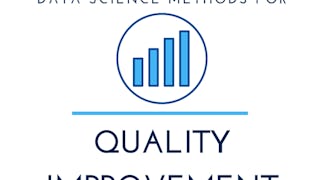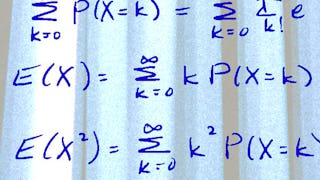In this course, you will learn the basics of understanding the data you have and why correctly classifying data is the first step to making correct decisions. You will describe data both graphically and numerically using descriptive statistics and R software. You will learn four probability distributions commonly used in the analysis of data. You will analyze data sets using the appropriate probability distribution. Finally, you will learn the basics of sampling error, sampling distributions, and errors in decision-making.


Managing, Describing, and Analyzing Data
This course is part of Data Science Methods for Quality Improvement Specialization

Instructor: Wendy Martin
5,633 already enrolled
Included with
(34 reviews)
Recommended experience
What you'll learn
Calculate descriptive statistics and create graphical representations using R software
Solve problems and make decisions using probability distributions
Explore the basics of sampling and sampling distributions with respect to statistical inference
Classify types of data with scales of measurement
Skills you'll gain
Details to know

Add to your LinkedIn profile
11 assignments
See how employees at top companies are mastering in-demand skills

Build your subject-matter expertise
- Learn new concepts from industry experts
- Gain a foundational understanding of a subject or tool
- Develop job-relevant skills with hands-on projects
- Earn a shareable career certificate

There are 5 modules in this course
Upon completion of this module, students will be able to use R and R Studio to work with data and classify types of data using measurement scales.
What's included
7 videos3 readings2 assignments2 discussion prompts
Upon completion of this module, students will be able to use R and RStudio to create visual representations of data, and calculate descriptive statistics to describe location, spread and shape of data.
What's included
11 videos3 assignments2 discussion prompts
Upon completion of this module, students will be able to apply the rules and conditions of probability and probability distributions to make decisions and solve problems using R and R Studio.
What's included
8 videos2 assignments1 discussion prompt
Upon completion of this module, students will be able to use R and RStudio to characterize sampling and sampling distributions, error and estimation with respect to statistical inference.
What's included
8 videos2 assignments1 discussion prompt
Upon completion of this module, students will be able to use R and RStudio to perform statistical tests for two groups with independent and dependent data.
What's included
13 videos2 assignments
Earn a career certificate
Add this credential to your LinkedIn profile, resume, or CV. Share it on social media and in your performance review.
Build toward a degree
This course is part of the following degree program(s) offered by University of Colorado Boulder. If you are admitted and enroll, your completed coursework may count toward your degree learning and your progress can transfer with you.¹
Instructor

Offered by
Explore more from Probability and Statistics
 Status: Free Trial
Status: Free TrialUniversity of Colorado Boulder
 Status: Free Trial
Status: Free TrialJohns Hopkins University
 Status: Free Trial
Status: Free TrialUniversity of Colorado Boulder
 Status: Free Trial
Status: Free TrialUniversity of Colorado Boulder
Why people choose Coursera for their career




Learner reviews
34 reviews
- 5 stars
77.14%
- 4 stars
17.14%
- 3 stars
5.71%
- 2 stars
0%
- 1 star
0%
Showing 3 of 34
Reviewed on Mar 12, 2021
The instructor is clear and easy to follow. The lessons are succinct. It helps to be familiar with the topics already.
Reviewed on Aug 18, 2024
This is the course you can actually master the content in the course
Reviewed on Apr 18, 2021
We learned some theory and practiced in R. A perfect combination!

Open new doors with Coursera Plus
Unlimited access to 10,000+ world-class courses, hands-on projects, and job-ready certificate programs - all included in your subscription
Advance your career with an online degree
Earn a degree from world-class universities - 100% online
Join over 3,400 global companies that choose Coursera for Business
Upskill your employees to excel in the digital economy
Frequently asked questions
To access the course materials, assignments and to earn a Certificate, you will need to purchase the Certificate experience when you enroll in a course. You can try a Free Trial instead, or apply for Financial Aid. The course may offer 'Full Course, No Certificate' instead. This option lets you see all course materials, submit required assessments, and get a final grade. This also means that you will not be able to purchase a Certificate experience.
When you enroll in the course, you get access to all of the courses in the Specialization, and you earn a certificate when you complete the work. Your electronic Certificate will be added to your Accomplishments page - from there, you can print your Certificate or add it to your LinkedIn profile.
Yes. In select learning programs, you can apply for financial aid or a scholarship if you can’t afford the enrollment fee. If fin aid or scholarship is available for your learning program selection, you’ll find a link to apply on the description page.
More questions
Financial aid available,

